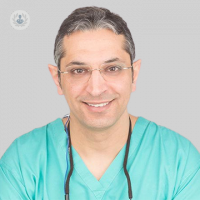FAQ: cervical spinal surgery
Written by:Leading consultant spinal surgeon Mr Khalid Salem provides the answers to some of the most frequently asked questions about cervical spinal surgery.

What does cervical spinal surgery treat?
Cervical spinal surgery aims to treat pathologies affecting the spinal cord or nerve roots in the neck. The surgery is performed through either an anterior approach (i.e., from the front part of the neck) or a posterior approach (i.e., from the back of the neck). Each approach has its advantages and disadvantages, typically chosen based on the underlying pathology being treated.
Cervical spinal surgery is performed in order to correct problems in the spinal cord or nerve roots in the neck. The surgery can be done from the front (anterior approach) or the back (posterior approach) of the neck. Every approach has its merits and drawbacks, and the decision relies on the particular problem that requires resolution.
What happens during cervical spine surgery?
Access to the neck is crucial in cervical and spinal surgery. The anterior approach is a refined route between the soft tissues in the front of the neck. In contrast, the posterior approach is slightly more invasive, requiring detachment of muscles and bones at the back of the neck.
Both approaches aim to alleviate pressure on nerves caused by underlying pathology and provide stability to the spine. Disks can be emptied, allowing visualisation of the spinal cord or nerves before using a pre-planned replacement, such as a fusion cage or disc replacement.
Posterior spinal surgery aims to provide a wide cross-sectional area for the spinal cord, aiding recovery and healing.
How long does it take to recover from cervical neck surgery?
Recovery from cervical spinal surgery is performed rather quickly, with the majority of patients staying overnight in the hospital and returning home the following day.
Anterior surgery minimises postoperative pain due to minimal soft tissue disruption. However, some patients may experience temporary difficulty swallowing or hoarseness of the voice. Posterior surgery may be slightly more painful, but pain typically decreases over a few days.
Does cervical spine surgery affect mobility?
Patients usually do not notice a significant reduction in neck range of motion after spinal surgery. Fusion components may marginally reduce the segmental range of motion, but advancements in technology now allow for the restoration of disk height and the simulation of natural spinal column movement.
What is motion preserving cervical spine surgery?
While fusion has been the gold standard, motion preservation implants have shown promising results in preserving motion and reducing stress on adjacent segments. Patient-reported outcome measures suggest that certain motion preservation implants may be better than fusion procedures in some cases.
What are the pros and cons of motion-preserving cervical spine surgery?
Despite the benefits, motion preservation carries risks, such as the replacement device not functioning as planned, potential wear and tear of implants over time, and the inadvertent fusion of the segment due to bone overgrowth. However, these risks are generally minimal compared to the potential advantages of preserving motion in the spine.
If you would require cervical spinal surgery and would like to book a consultation with Mr Salem, simply visit his Top Doctors profile here today


